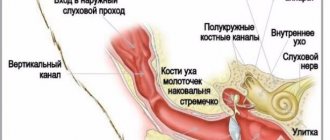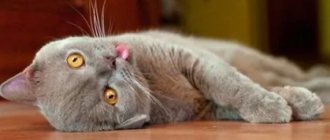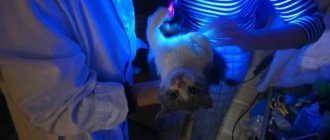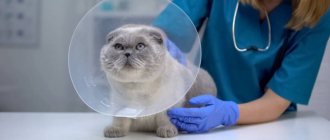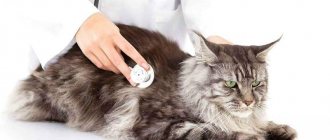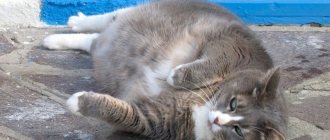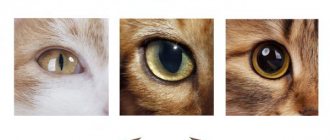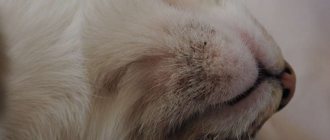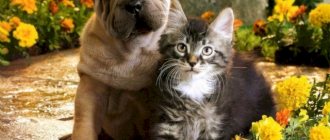6938Administration
Everyone knows that a cat's tail is a kind of indicator of the mood of a four-legged pet. A dissatisfied, excited or angry cat signals its feelings by twitching this part of its body. The tail is also necessary for coordinating cat movements. In some cases, you can observe a crooked tail in cats. This phenomenon is much more common in cats than in dogs. What does this feature mean? What causes a crease to form and is it dangerous to the cat’s health?
Congenital tail defects
We are talking about a structural feature of the tail, which occurs quite often in newborn kittens. According to statistics, some cat breeds are especially susceptible to congenital tail defects (for example, Burmese or Scottish fold cats).
In itself, such a hall is not scary and does not in any way threaten the life or health of the pet. You just have to remember that if a cat has a broken tail, the path to exhibitions and competitions among its own kind will be closed. Such an individual is considered to be out of condition, that is, not suitable in terms of body structure parameters. So an animal with a congenital crease will delight the eye and heart exclusively at home. You will have to forget about the career of a “cat model”.
Another important factor is the ability of cats to pass on the peculiarity of their tail structure by inheritance. In other words, future kittens have every chance of repeating the fate of the “crooked-tailed” parent. Moreover, this anomaly may worsen, and the offspring may develop complications in the form of spinal disorders, coordination of movements and many other troubles. This is why an animal with a crooked tail is not suitable for breeding. The best way out of the situation would be castration or sterilization.
Main predisposing factors
There are quite a few of them, but more often than others, various kinds of “tail” injuries lead to this phenomenon. For example, breeders living in rural areas and private homes often have crooked-tailed pets. What is this connected with? When a cat is let out for a walk, sometimes he does not have time to pull out his tail before the door closes... As a result, a fracture or serious injury to the tail. Since splints and plaster are rarely applied to this part of the body, the cat continues to walk, “flaunting” the damage. It heals poorly and takes a long time, which is why the animal has a “poorly” healed injury for the rest of its life. It is she who forms the crease of the tail.
Does this pose any danger to the cat's health or life? In principle, no. Your pet will not look very presentable, but there is no threat to it either . In theory. In the case when the tail has healed long ago, and only its strange bend reminds of the incident, there really is no reason for concern. It’s a different matter in situations where the organ has not yet healed, when there is an unhealed wound/ulcer directly at the site of injury, etc.
In these places, all damage is quickly contaminated with pathogenic and conditionally pathogenic microflora, as a result of which an inflammatory process develops. It’s not at all good when pyogenic or generally putrefactive bacteria get into the wound. A foul-smelling exudate begins to flow from the wound on the tail, in severe cases abundantly mixed with pieces of dead tissue.
Fracture as a result of injury
Often a crease in the tail appears as a result of injury..
Blows, bites, falls from a height, a tail pinched by a door - this is not a complete list of reasons for a cat's tail to be bent. Unfortunately, the owner does not always pay due attention to this fact, and even less often a splint, plaster, or at least a pressure bandage is applied to the damaged area. The cat continues to live with a damaged tail. The injury heals slowly and poorly, resulting in an improperly healed injury. This is what provokes the appearance of a crease.
© shutterstock
Head injuries or diseases of the nervous system suffered by the cat are considered even more dangerous. In such cases, pinching of the bundle of nerves in the caudal region and damage to the spinal cord may occur. In such cases, the pet's tail may take on an atypical shape.
Sometimes, after an injury, a crease in the tail appears and at the same time, the animal exhibits strangeness in its gait. If a crooked tail is accompanied by disturbances in motor activity or the cat begins to have difficulty oriented in space, this is a serious reason to contact a veterinarian.
First aid
If it is not possible to take the cat to the veterinarian immediately, you should try to help the pet yourself. First of all, you need to clean the wound of dirt. Boiled water or saline solution is suitable for these purposes. It is very important that nothing gets into the wound, otherwise the risk of infection increases. Therefore, the hair around the wound must be carefully trimmed so as not to cause hair loss.
© shutterstock
The next step is to apply ointment to the edges of the wound. Levomekol, ichthyol or tetracycline ointment are suitable for these purposes. There is no need to rub the product into the wound. A thick layer of ointment covers the injured surface with an oily film and prevents the necessary oxygen from entering.
After all these procedures, cover the wound with a piece of soft and clean cloth and begin to apply a bandage. This stage is usually the most difficult. It is important to fix the bandage in such a way as not to block the access to air and at the same time not to pinch the important vessels of the tail. In addition, you need to avoid a situation where the cat throws off the bandage from the injured area. If the owner cannot cope with all these manipulations on his own, one of the family members should be enlisted to help.
In the following days, you need to monitor the condition of the pet’s tail and behavior. If the bandaged fabric is moderately covered with blood stains, it means that the healing process is proceeding normally and the owner can only systematically change the bandage. If pus mixed with blood oozes from the wound and an unpleasant odor emanates from the wound, the cat should be immediately transported to a veterinarian.
To prevent a situation in which the cat's tail is broken, the owner should pay increased attention to his pet. Avoid injuring the animal by closing the door. Make sure that the cat's tail is not damaged while playing with other pets (cat, dog or puppy). Protect the animal from falls from heights, impacts and other dangers. Compliance with these conditions is the key to the beauty and correctness of the cat’s tail.
As you know, a cat’s tail is a kind of “mood pendulum” for these animals. If your pet is excited or dissatisfied with something, she begins to jerk it vigorously. In addition, some cats are even able to “inform” their owners about their mood with the expressive bends of their tail.
If you are attentive and curious, then with the help of this Morse code you can quickly establish a relationship with your pet. But it happens that the cat’s tail takes on some unnatural positions, which immediately worries the breeders. Do you know why a cat's tail becomes curled, and what this phenomenon can mean? If not, then you can find out about it from our article!
Host actions
What should an owner do if he discovers that his pet has a broken tail tip, base or middle part? The procedure depends largely on the duration of the injury :
- Old kink . Sometimes the fact of injury goes unnoticed by the owner and the tail gradually heals on its own. In this case, if nothing bothers the pet, no measures need to be taken.
- "Fresh" injury . The situation is completely different if the cat’s tail injury occurred just recently and was quite serious.
Putrefactive bacteria can enter the wound, after which suppuration and foul-smelling discharge will begin.
Therefore, if the cat has suffered a tail injury (of any severity), you should not start this process. The pet needs to be taken to the veterinarian urgently. Typically, a tail injury can be corrected with a tight bandage or cast. In extremely severe cases, the tail may be amputated above the fracture site.
First aid
If it is not possible to take the cat to the veterinarian immediately, you should try to help the pet yourself. First of all, you need to clean the wound of dirt. Boiled water or saline solution is suitable for these purposes. It is very important that nothing gets into the wound, otherwise the risk of infection increases. Therefore, the hair around the wound must be carefully trimmed so as not to cause hair loss.
The next step is to apply ointment to the edges of the wound. Levomekol, ichthyol or tetracycline ointment are suitable for these purposes. There is no need to rub the product into the wound. A thick layer of ointment covers the injured surface with an oily film and prevents the necessary oxygen from entering.
After all these procedures, cover the wound with a piece of soft and clean cloth and begin to apply a bandage. This stage is usually the most difficult. It is important to fix the bandage in such a way as not to block the access to air and at the same time not to pinch the important vessels of the tail. In addition, you need to avoid a situation where the cat throws off the bandage from the injured area. If the owner cannot cope with all these manipulations on his own, one of the family members should be enlisted to help.
Genetic pathologies
Are there other causes of curvature of the tail in cats? Yes, and there are quite a lot of them. In particular, in the Burmese breed, a crooked tail is an extremely common pathology that is inherited. Sometimes a litter can contain more than 50% of these kittens. Of course, animals with such a defect are strongly recommended to be excluded from the reproduction process, but in reality this is not always possible. Owners of “crippled” pets can take comfort in the fact that the pathology does not in any way affect the health and quality of life of the cat.
It is much worse and more dangerous when the curvature of the tail is caused by some kind of neurological disorder. For example, pathology can develop after severe head injuries or diseases accompanied by damage to the nervous system. Finally, the tail can take on “extravagant” shapes after pinching, injuries to the back and specifically the spine. The fact is that with these pathologies there is a very high risk of pinched nerve bundles and damage to the spinal cord.
Important! So if the curvature of the tail is accompanied by a shaky and uncertain gait of the pet, you often notice that he has poor orientation in space, you must definitely contact a veterinarian.
Causes of dandruff in cats and kittens
There are 3 types of dandruff in cats:
- oily seborrheic dermatitis;
- dry;
- mixed.
In the first case, the sebaceous glands, under the influence of negative factors, synthesize too much lubricating secretion. With dry seborrhea, the process is reversed - there is not enough fat lubrication, the dried skin begins to peel off.
You can’t ignore dandruff in a cat, because the most common cause is a bacterial or fungal infection. Pathogenic microorganisms, having penetrated the epithelium, kill cells, resulting in increased exfoliation.
There are other possible causes of dandruff in pets. External:
- insufficient care of cat hair (rare or too frequent bathing, drying out the skin, poor combing, unsanitary conditions in the home);
- incorrectly chosen preparations for hair care;
- frequent exposure to direct ultraviolet radiation, sunburn (the skin dries out, becomes horny, heat exchange is disrupted);
- dry air in the home (the cat not only develops dandruff, but also cracks the skin on the pads of its paws);
- constant stress;
- external parasites – fleas, lice eaters, ticks (infection is accompanied by intense itching and redness of the skin);
- microscopic skin injuries (scratches from a hard comb).
Internal provoking factors:
- allergic reaction to food, toys, skin parasites;
- obesity, incorrectly composed animal diet, lack or excess of vitamins, nutrients, mineral elements;
- diseases of the endocrine and digestive systems, hormonal disorders (dandruff certainly forms when the thyroid gland, which regulates lipid metabolism and the synthesis of sebaceous secretions, malfunctions);
- infectious skin lesions (with ringworm in cats, seborrhea is always observed);
- side effects of certain veterinary drugs;
- hereditary predisposition (idiopathic seborrheic dermatitis is incurable, temporary elimination of symptoms is possible).
Local treatment
Washing sticky brown discharge from skin and fur is truly difficult. It is necessary to choose a shampoo with anti-inflammatory and keratolytic effects. There is no need to wash the whole cat; only problem areas are treated.
For greasy tail, the following are recommended:
- Zoohygienic shampoo "Doctor".
Treatment begins with daily treatments, and contact of the foam with the skin should be at least 5-7 minutes. Then the tail is washed at intervals of 1-3 days until the skin is in satisfactory condition.
For dark-colored show animals, keep in mind that shampoo may lighten the fur slightly.
- Shampoos with chlorhexidine 4% (Global Vet, Doctor VIC, Api-San).
This detergent is prescribed for severe pyoderma. The shampoo will effectively destroy pathogenic fungi and bacteria and relieve inflammation. It is necessary to keep the foam for 5-10 minutes, the treatments are repeated after 3-5 days for a month.
- Specialized products for very oily coats.
Before the show, you can use deep cleansing shampoos such as Jerob One-Step Grease Removing (USA, An-Ju). Apply the product to wet fur, after 3 minutes foam with water and rinse thoroughly.
After washing, the final rinse can be carried out with herbal infusions and decoctions - chamomile, calendula.
Ointments with antifungal, antibacterial effects, as well as hormonal ointments can only be used as prescribed by a dermatologist. When using such products, the cat must wear an “Elizabethan” protective collar to prevent licking and swallowing of the medicine. To have an effective effect on the skin, the hair (if it has not fallen out previously) must be cut short.
After the course of treatment, excess sebum can be removed using dry powder shampoos, because cats hate washing. Use:
- Trixie Trocken Shampoo;
- Beaphar Grooming Powder;
- Croci Gills;
- regular starch, baby powder.
The powder is applied against the grain, rubbing gently. Then you need to comb it thoroughly using a natural bristle brush.

